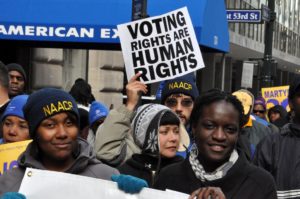
Protestors gather in New York City for the Occupy Wall Street’s march for voting rights on Dec. 10, 2011. (Courtesy: Flickr)
The United States Supreme Court’s decision to review a challenge to Ohio’s voters roll purge policy brings the question of voter discrimination to the forefront again.
In a case brought by Black trade unionist organization the A. Phillip Randolph Institute, the Northeast Ohio Coalition for the Homeless and Larry Harmon, an Ohio voter, Ohio’s “Supplemental Process” is being challenged as a violation of the National Voter Registration Act of 1993 and the Help America Vote Act of 2002.
Since the 2013 Supreme Court decision Shelby v. Holder that gutted Section 5 of the Voting Rights Act, which required Southern states with a history of discrimination to get Justice Department approval before changing their voting laws, a stream of new “voting laws” have become commonplace. Be it voters roll purges, restricting voter registration or access to actual voting, the growing number of voter disenfranchisement cases speaks of a changing populace and the lengths some will go to to hold on to power.
To a certain extent, federal law mandates voters roll purges. The Help America Vote Act — which passed under George W. Bush to help eliminate the “dangling chad” problem of the 2000 presidential election, where punch-card ballots led to the spoiling of almost two million votes — requires the maintenance of accurate and timely registration databases. The problem is that the law does not clearly enumerate how this is supposed to happen. Many states have developed poorly or maliciously designed purging rules that have led to the disenfranchisement of lawful, eligible voters.
“Ohio’s practice of purging infrequent voters from the rolls has prevented countless eligible Ohioans from casting their votes and making their voices heard, and violates the National Voter Registration Act (NVRA),” Brenda Wright, vice president for policy and legal strategies at Demos, said in a statement. “The NVRA clearly prohibits states from systematically preventing eligible persons from exercising their right to vote by removing voters from the rolls based on their failure to vote.”
Understanding Voters Roll Purges
To begin with, it should be noted that voters roll purges are not necessarily a bad thing. Just as a shark is an important part of the ecosystem, voters roll purges are meant to keep the voting ecology on track. As envisioned by the Help America Vote Act, voters roll purges are meant to shrink voter registration rolls of the nonvoters that could slow down or otherwise impede same-day registration or on-site voting.
Most states remove voters either at the request of the voters themselves or with tangential proof, such as notification of voter registration from another state, notification of change of state driving license, notification of address change or notification of death. Ohio’s strategy however is to target “occasional” voters for exclusion. Ohio, one of a few states to punish nonvoting with the possibility of de-registration, defined “occasional” as not voting in a two-year period.
This is problematic because many Democrats only vote in presidential elections. The way Ohio’s law is set up theoretically punishes voters that sit out mid-term elections or voters who abstain from voting during a federal election, without consideration of why they may not be voting. Many working-class voters, for example, may not be able to get time off from work to vote — despite federal labor laws that mandate employers provide employees with paid voting time, if needed — or may not be able to secure transportation or child care.
“Ohio has purged hundreds of thousands of people from the voters rolls simply because they have exercised their right not to vote in a few elections,” Freda Levenson, legal director of the American Civil Liberties Union of Ohio, said in a statement. “This purge process violates the National Voter Registration Act. We are confident that the Supreme Court will uphold the correct decision from the Sixth Circuit Court of Appeals and will ultimately ensure that eligible Ohio voters may not be stricken from the rolls.”
According to Reuters, the repercussion of Ohio’s voters roll purge could be extreme. An examination of Ohio’s three largest counties — which include the cities of Cleveland, Cincinnati and Columbus — found that purging efforts disenfranchised neighborhoods with a high proportion of poor, Black residents the hardest. The Reuters analysis found that, because Republicans participate in mid-term elections at a higher rate than Democrats, Ohio’s voters roll purge mandate hits Democrats 2:1 to Republicans. With more than 144,000 residents purged under this law between 2012 and 2016 in just the three counties — more than Barack Obama’s margin of victory in the state in 2012 — this can make a significant difference in a swing state that has been instrumental in presidential elections.
Ohio Secretary of State Jon A. Husted, who supports the law and who is running to be the Republican nominee for governor in 2018, argues that voters who do not vote have themselves to blame. The Ohio law requires voters who have been contacted regarding potential removal to contact their board of elections by postcard or to engage in an electoral action — such as voting, requesting a change of address with the board or filing an application for an absentee ballot — within four years following the notice. “If this is really an important thing to you in your life — voting — you probably would have done so within a six-year period,” Husted said in an interview.
Ohio’s law also requires that de-registered voters re-register 30 days before an election. This, in effect, excludes those who learned of their loss of registration at the voting place from getting emergency relief. This includes many of the “occasional” voters who helped to elevate Obama to the presidency in 2008.
The National Voting Rights Act prohibits states from eliminating voters from voting rolls for simply not voting. However, because HAVA gives the states dominion to decide how to manage their own rolls and because the Supreme Court has traditionally been lax in protecting voting rights, Ohio’s voters roll law has a fair chance of surviving the conservative-slanted Court.
“It is hard to prove if all of this is being done for partisan reasons,” Rich Saphire, professor emeritus at the University of Dayton School of Law and advising attorney with the ACLU, said. The ACLU is monitoring this and other voters roll purge cases and has spoken out against the use of the practice for discriminatory reasons.
“The data simply does not show a pattern that can be easily pointed out,” Saphire said. “However, as we do know who these laws would likely hurt, we can make a guess at the motivations behind them.”

President Lyndon B. Johnson presents a pen to the Rev. Dr. Martin Luther King Jr. during the signing of the Voting Rights Act. (Courtesy: Wikimedia)
Redefining the Right to Vote
This case follows the tide of recent Supreme Court challenges to race-based redistricting in North Carolina and Georgia. The attempt to curtail voting access continues a chain of voting challenges that started with the controversial 2013 Supreme Court ruling to overturn the Voting Rights Act coverage formula. The coverage formula determined which areas of the United States the Department of Justice could request pre-clearance from for any potential voting access change. These areas were regions that were identified as being the most likely to pass restrictive or discriminatory voting access legislation.
Without the coverage formula, the Justice Department has no prescribed regions to oversee, effectively killing the prerequisite requirement. Former pre-clearance states have taken full advantage of their new freedom. Texas, for example, has since passed a redistricting map that exploited “racial packing” and other methodologies — such as stricter voter ID rules — to maintain and strengthen Republican control of the state, despite a growing Latino population.
North Carolina issued what was called the worst voter ID bill in recent history. The law reduced the number of voting sites, slashed the days of early voting, eliminated same-day registration and pre-registration of 16- and 17-year olds, prevented counties from extending voting hours to accommodate long lines, banned the use of college IDs as voting IDs and outlawed certain types of voter registration drives. This was topped with an aggressive redistricting effort that created two majority-minority “super-districts” that effectively siphoned the Black vote from the majority of the other state districts.
These efforts have been driven by the republican accusations of massive voter fraud. Despite the fact that voting fraud is statistically exceptionally rare in the United States, the reality is that incident rates of voter fraud are between 0.0003 and 0.0025, per the Brennan Center for Justice. It’s statistically easier to get struck by lightning in the United States than to successfully commit impersonation voter fraud. Republicans however use the specter of electoral misdeeds to justify restrictive voting legislation.
Since the inception of the 1993 National Voter Registration Act, which permitted state departments of motor vehicles to include voter registration forms on applications and renewal forms, the GOP has argued that the ease of registration could invite possible fraud, especially in light of the fact that no federal agency was in charge of supervising this expansion.
Today, this false narrative of voter fraud is interwoven with the Republicans’ core platform. Donald Trump’s oft-repeated claim that millions of votes in the 2016 presidential election were falsely recorded and his promise to “investigate” this may be more than just his effort to sooth a bruised ego that can’t get passed winning the presidency despite losing the popular vote. It may be an effort to silence voters who may vote against him and the Republicans in 2020 and throughout the foreseeable future.
Partisanship Today
With partisanship in the United States on the rise, there is a valid concern that the aggressive use of discriminatory voting practice may turn the United States into effectively an oligarchy, where politicians choose who can vote and who they can vote for.
“This can definitely be considered a crisis of our system of democracy,” Wright said. “The problem is not that there are too many people voting. The problem is that there are eligible voters that cannot vote. We must put our energy into working to get these people registered and ensuring that there are no encumbrances toward their implementation of their constitutional right.”
Wright pointed out that the level of voter disenfranchisement today makes this time in American history unique. While the nature of party politics suggests that the party in power takes advantage of the situation to enhance and maintain its power, not since Reconstruction has a party taken the steps the Republican Party has to not only limit the size of the electorate but also to deny voters the right to pick a representative who actually represent them. Wright states. “If we as a democracy are to continue, we must be willing to hear everyone and not just those that agree with us.”


